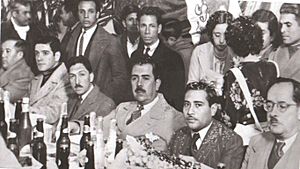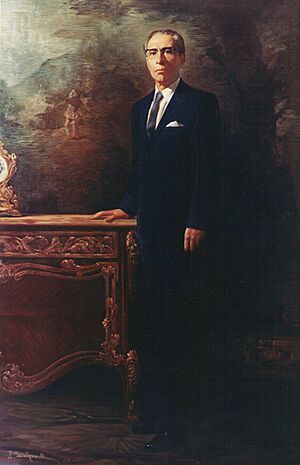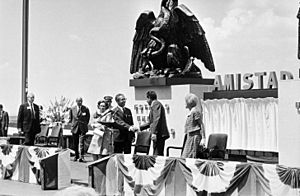Gustavo Díaz Ordaz facts for kids
Quick facts for kids
Gustavo Díaz Ordaz
|
|
|---|---|
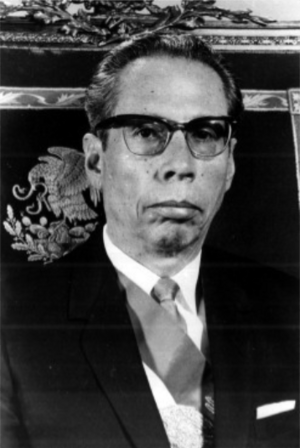
Official portrait, 1964
|
|
| 56th President of Mexico | |
| In office 1 December 1964 – 30 November 1970 |
|
| Preceded by | Adolfo López Mateos |
| Succeeded by | Luis Echeverría |
| Secretary of the Interior of Mexico | |
| In office 1 December 1958 – 16 November 1964 |
|
| President | Adolfo López Mateos |
| Preceded by | Ángel Carvajal Bernal |
| Succeeded by | Luis Echeverría |
| Senator of the Congress of the Union for Puebla |
|
| In office 1 September 1946 – 31 August 1952 |
|
| Preceded by | Noé Lecona Soto |
| Succeeded by | Luis C. Manjarrez |
| Member of the Chamber of Deputies for Puebla's 1st district |
|
| In office 1 September 1943 – 31 August 1946 |
|
| Preceded by | Blas Chumacero |
| Succeeded by | Blas Chumacero |
| Personal details | |
| Born |
Gustavo Díaz Ordaz Bolaños
12 March 1911 San Andrés, Puebla, Mexico |
| Died | 15 July 1979 (aged 68) Cerrada del Risco 133, Jardines del Pedregal, Mexico City, D.F., Mexico |
| Resting place | Panteón Jardín, Mexico City, Mexico |
| Political party | Institutional Revolutionary Party |
| Spouse |
Guadalupe Borja
(m. 1937; died 1974) |
| Children | 3 |
| Alma mater | University of Puebla |
| Profession | Politician |
Gustavo Díaz Ordaz Bolaños (born March 12, 1911 – died July 15, 1979) was a Mexican politician. He was a member of the Institutional Revolutionary Party (PRI). He served as the President of Mexico from 1964 to 1970.
Díaz Ordaz was born in San Andrés Chalchicomula. He earned a law degree from the University of Puebla in 1937. Later, he became the university's vice-rector. He represented Puebla's first district in the Chamber of Deputies from 1943 to 1946. After that, he represented the same state in the Chamber of Senators from 1946 to 1952. During this time, he became good friends with Senator Adolfo López Mateos.
Díaz Ordaz joined the campaign of Adolfo Ruiz Cortines for the 1952 election. He then worked for the Secretariat of the Interior under Ángel Carvajal Bernal. He became the Secretary of the Interior after López Mateos won the 1958 election. He often handled presidential duties when the president was away, especially during the Cuban Missile Crisis. In 1963, the PRI announced him as their candidate for the 1964 election. He won with a large majority of the votes.
His time as president is mostly remembered for the student protests in 1968. These protests happened around the time of the 1968 Summer Olympics in Mexico City. The government and army responded with force, leading to the Tlatelolco massacre. Many unarmed protesters lost their lives during this event.
After his presidency, Díaz Ordaz retired from public life. He briefly served as the Ambassador to Spain in 1977. However, he resigned due to strong public criticism. He passed away on July 15, 1979, at the age of 68, from a type of cancer.
Contents
Early Life and Education
Gustavo Díaz Ordaz Bolaños was born in San Andrés Chalchicomula (now Ciudad Serdán, Puebla). He was the second of four children. His father, Ramón Díaz Ordaz Redonet, worked as an accountant. The family often faced financial difficulties and moved frequently.
His mother, Sabina Bolaños Cacho de Díaz Ordaz, was a school teacher. When the family lived in Oaxaca, young Díaz Ordaz attended the Institute of Arts and Sciences. This school had famous alumni like Benito Juárez. He was a serious student, but his family's money problems sometimes made it hard to buy school books.
Díaz Ordaz earned his law degree from the University of Puebla in 1937. He later became a professor there. He also served as the university's vice-rector from 1940 to 1941.
Early Political Career
Díaz Ordaz began his political career in the government of Puebla. He served there from 1932 to 1943. In 1943, he became a federal politician. He served in the Chamber of Deputies for Puebla's first district. From 1946 to 1952, he was a senator for the same state.
He gained national attention when he joined the cabinet of President Adolfo López Mateos. He served as the Minister of the Interior (Gobernación) from 1958 to 1964. On November 18, 1963, he became the presidential candidate for the Institutional Revolutionary Party (PRI). He won the presidential election on July 5, 1964.
Presidency of Gustavo Díaz Ordaz
Díaz Ordaz became president on December 1, 1964. The ceremony took place at the Palacio de Bellas Artes. He took his oath before the Congress of the Union. Former president Adolfo López Mateos handed him the presidential sash.
Domestic Policies and Challenges
As president, Díaz Ordaz was known for his strong leadership. He showed this strictness in how he handled protests. For example, railroad workers, teachers, and doctors were fired for going on strike. He used force to end a strike by doctors who wanted better pay and working conditions.
His strict way of governing led to some resistance. Armed groups, known as a guerrilla movement, appeared in the state of Guerrero. However, economically, Mexico experienced growth during his presidency. He created the Mexican Institute of Petroleum in 1965. This was an important step, as oil is a key industry for Mexico.
Student Movement and Tlatelolco
In 1968, university students in Mexico City protested against the government. This happened around the time Mexico was preparing to host the 1968 Summer Olympics. Díaz Ordaz oversaw the occupation of the National Autonomous University of Mexico. Many students were arrested.
On October 2, 1968, a tragic event known as the Tlatelolco massacre occurred in Downtown Mexico City. During a student protest, the Mexican army fired on unarmed protesters. Many people lost their lives. The exact number of casualties varies. Some people were imprisoned for several years after this event.
Later, other Mexican presidents criticized this crackdown. Many Mexicans still view the attack on students as a terrible event. The memory of this incident remained a negative mark on the PRI party for many years. Each year, on the anniversary of the Tlatelolco massacre, the statue of Díaz Ordaz in Zapopan, Jalisco, is marked with red paint.
Efforts to Change the PRI Party
Díaz Ordaz's strong leadership also stopped efforts to make the PRI party more democratic. The president of the PRI, Carlos Madrazo, tried to introduce internal party elections. He hoped this would make the party stronger from within. When his attempt failed, Madrazo resigned.
Foreign Policy
Relations with the United States
During Díaz Ordaz's time as president, Mexico's relationship with the United States was mostly good. Several agreements were made between the two countries. For example, President Richard Nixon hosted a special dinner for Díaz Ordaz in San Diego in 1970.
However, there were also some disagreements. One was the "Operation Intercept" by the U.S. This operation involved inspecting all vehicles entering the U.S. from Mexico in late 1969. Mexico also believed in not interfering in other countries' affairs. Díaz Ordaz spoke out against the U.S. invasion of Santo Domingo, the capital of the Dominican Republic.
Treaty of Tlatelolco
Under his leadership, the Treaty of Tlatelolco was signed. This important treaty banned the production, ownership, or use of nuclear weapons in Latin America. Only peaceful uses of nuclear energy were allowed. This treaty made Latin America a nuclear weapon-free zone.
Later Life and Legacy
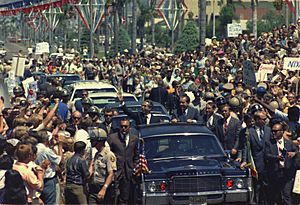
After his term as president ended, Díaz Ordaz and his family largely stayed out of the public eye. He rarely gave interviews and was mostly seen only when voting.
In 1977, he was appointed as the first Mexican Ambassador to Spain in 38 years. Relations between the two countries had been broken for a long time. However, during his short time as Ambassador, he faced strong criticism from both Spanish and Mexican media. People often asked him about his actions as president. He resigned within a few months due to the protests and his health issues.
Gustavo Díaz Ordaz passed away on July 15, 1979, in Mexico City. He was 68 years old and died from a type of cancer. His remains were buried at Panteón Jardín.
The Licenciado Gustavo Díaz Ordaz International Airport in Puerto Vallarta is named after him.
Public opinion about Díaz Ordaz's presidency remains mostly negative. He is often associated with the Tlatelolco massacre. This event is seen as a symbol of a period of strict government control that continued under later PRI presidents. Even during his lifetime, his appointment as Ambassador to Spain in 1977 was met with such strong public disapproval that he had to resign quickly.
In a 2012 survey, 45% of people felt his presidency was "very bad" or "bad." Only 27% thought it was "very good" or "good." In 2018, the Government of Mexico City removed all plaques in the Mexico City Subway system that mentioned Díaz Ordaz. These plaques had been installed during his time as president.
See also
 In Spanish: Gustavo Díaz Ordaz para niños
In Spanish: Gustavo Díaz Ordaz para niños


